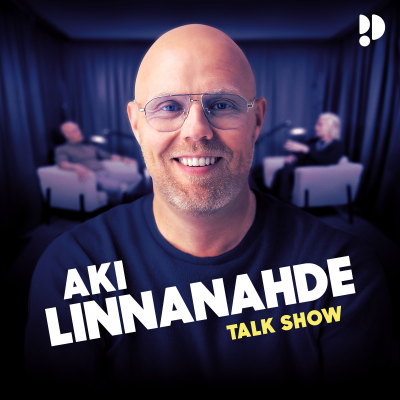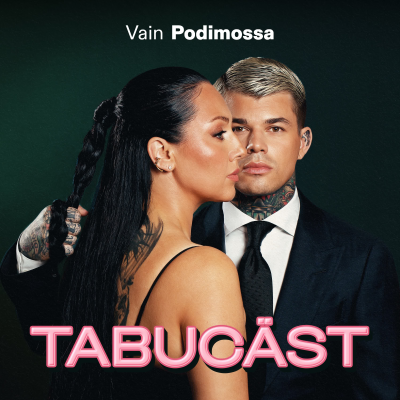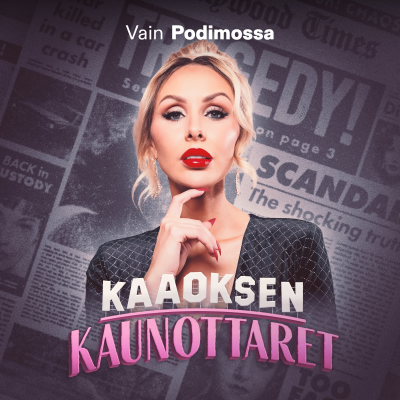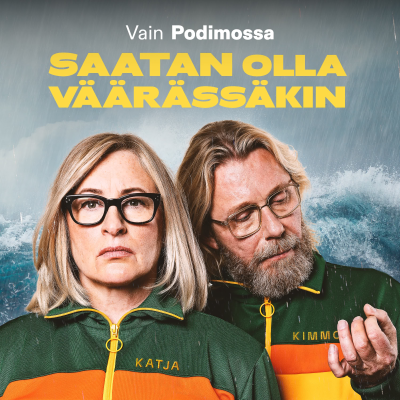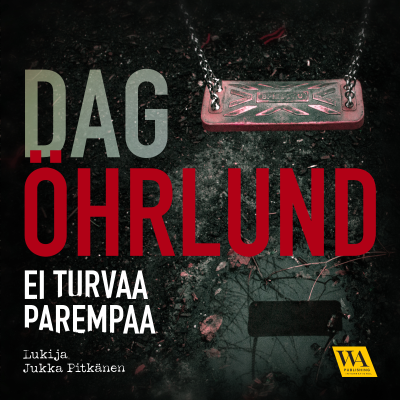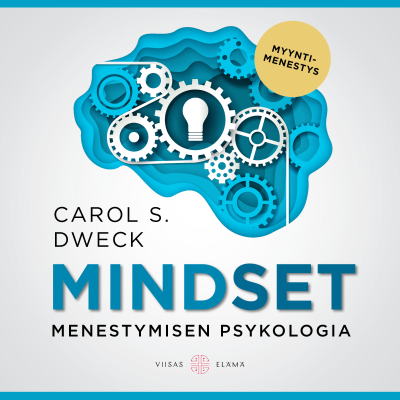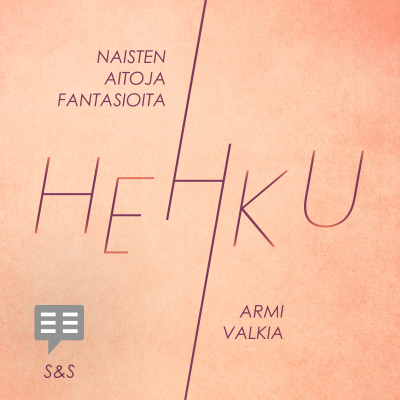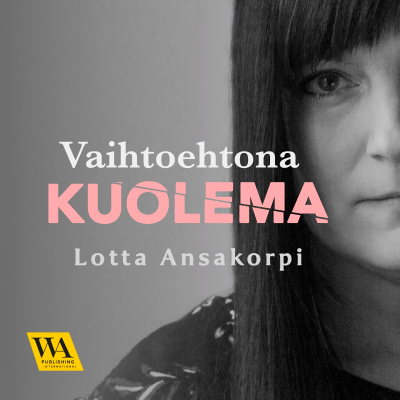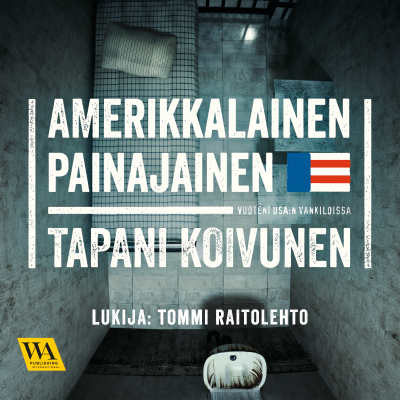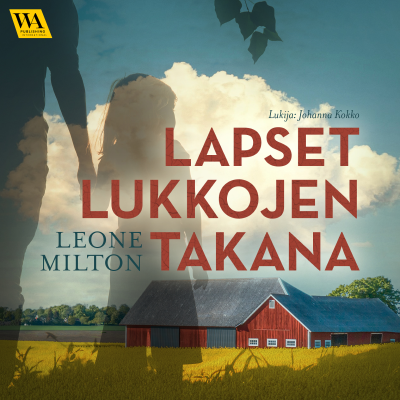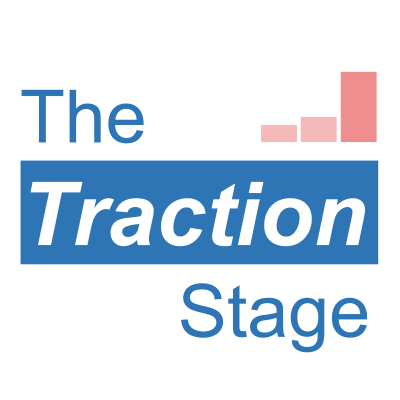
The Traction Stage
englanti
Talous & ura
Rajoitettu tarjous
1 kuukausi hintaan 1 €
Sitten 7,99 € / kuukausiPeru milloin tahansa.
- Podimon podcastit
- Lataa offline-käyttöön
Lisää The Traction Stage
Alexandre Azevedo interviews startup founders to learn about their journey from idea to the traction stage.
Kaikki jaksot
16 jaksotAbartys Health: Saving Lives by Providing Accurate Patients’ Data – with Dolmarie Mendez [Ep#21]
Abartys Health is a startup from Puerto Rico. It has created a system that allows seamless data flow and communication between insurers, doctors, and patients. Today, it has more than 1 million patients registered, 700,000 providers enrolled and $11 million in Annual Recurring Revenue. In our 21st episode, Dolmarie Mendez tells us Abartys traction story and how she turned a (very) tough moment in her life into a startup that is saving lives. Listen to the full episode here: SHOW NOTES The notes below are just part of the interview. Listen to the audio to get the whole episode! THE PROBLEM AND THE SOLUTION What is the problem you’re solving and what is the solution Abartys Health is providing to its customers? Today, we give insurance companies and providers a centralized place, where they can exchange information—like their credentials and all the documentation that evidence they are capable and they are up to date with all their license and documentations in order to treat a patient. A very high percentage of patients in the United States—to be exact 10%—die in the emergency room because they [payers and providers] don’t know anything about that patient. They don’t know if they are allergic to something—to penicillin or latex. Information about the patients is crucial in order that those patients get the right treatments. So, having the right information from the provider and having it available for the patients are crucial in order to be efficient. Abartys is providing a solution to mitigate the fragmentation in the healthcare systems. A VERY TOUGH TIME [https://i0.wp.com/thetractionstage.com/wp-content/uploads/2020/02/dolmarie-looking-at-smartphone.jpg?resize=800%2C617&ssl=1]How did you have the idea to build such a system? In 2014, I had an infection. I had a shock—a bad reaction to crop—while I was in one of my continuing education trips. I had poisoned food—something that sounds simple to treat. But, if it’s not treated right, it can bring complications later. I had a sepsis and I spent six months between hospitals. They didn’t know what was happening to me and no one was able to treat me in the right way, with the right treatment. I said goodbye to my family because they told me I was not going to recover. My weight was 81 pounds—I’m five, three inches. So, imagine, very small. I lost my hair, my intestinal flora. And I remember like yesterday, praying: “Oh, my God, if I recovered from this, definitely I’m going to dedicate my life to collaborate some way to fix this.” > And I remember like yesterday, praying: “Oh, my God, if I recovered from this, definitely I’m going to dedicate my life to collaborate some way to fix this.” That is the foundation of Abartys Health. After that, I got obsessed with wellness, prevention and making sure I have access to clinical data. That is the essence of our technology: access to clinical data and access to providers’ data. ZERO MONEY, BUT MANY CONTACTS How much money did you have when you decided building something together? We had no money. I was a vice-president of a benefits management agency at that moment. So, we proved our concept with the clients that we already have in here, managing their benefits. It’s about being strategic and wise about how you move all your stakeholders around you. When you are going to start a company, you need to keep your job, unless you have a good amount of money saved that you can go without nothing. [https://i0.wp.com/thetractionstage.com/wp-content/uploads/2020/02/image-5.jpg?fit=640%2C366&ssl=1]So, we started conversations with some of our friends, and a friend—of a friend of a friend—put us in contact with some people that could make some recommendations. Then, Lauren realized she had a friend that ran the physicist’s department at the University of Puerto Rico. We explained everything that he wanted to know and his first words were: “You are both crazy.” It was feedback that we were getting from everybody. > We explained everything that he wanted to know and his first words were: “You are both crazy.” It was feedback that we were getting from everybody. I know a ton of people in the healthcare industry here. So that gave me some perspective and data bank to go on talk and ask for feedback. And the feedback was: “We trust you. If you make that, just call me because I’m going to buy it immediately.” MONEY FROM AN UNEXPECTED SOURCE What did you do next? We needed to bring people with a fresh mind or thinking out of the box, that you just explained the problem, they learn from knowledge transfer, and they say: “What about this?” We built a lab with students from the University. We were not able to pay them. At the beginning, it was just our word: “We cannot pay you.” [https://i1.wp.com/thetractionstage.com/wp-content/uploads/2020/02/image-4.jpg?fit=640%2C423&ssl=1]Then, at that moment, I spoke with my employer and we had a good number of clients in the company—that were my clients—and they trusted me. So, I told him: “Hey, I have this personal commitment and I really want to do this.” And he trusted me too. He said: “I’m going to fund your project.” That’s our seed investor and that’s where we saw our first capital seed—$562,000. We used that money to build the company and to start with the technology. When did you have something to show people? We used another technology—a B2C product that you can buy online to manage wellness products—and it was like a third-party technology. We got the license and we started with two insurance companies here and employers to give them wellness benefits. We did clinics on side, physical exams on side. And then we challenged that vendor: “Hey, can we take lab results? Can we process the lab results?” And we did it. But we wanted something bigger. Because when we finished—after our case studies—we realized that we had the capacities to make this bigger. And then we said: “We’re going to build our technology.” PARALLEL18 We went to Parallel18 [https://parallel18.com/]—an international accelerator here—to visit another startup, in the first generation, that had something we thought we could use as part of our solution. When we explained everything to them, we already had the platform to start managing membership. And they said: “You don’t need another startup to do that. That’s an easy thing.” And we applied for the second generation [of Parallel18] from our cars. I remember we had like one hour left to submit the application and we got accepted. We were very lucky to be part of the second generation. There, they give you $40,000 without equity and we invested all the money to start paying the guys that were working for free. WORDS FOR STARTUP FOUNDERS Usually as startups, we are told: “Don’t show your idea. Don’t tell anything. Don’t talk to everybody.” And you need to be wise about that. It’s not about not talking; it’s about how to talk about that. And it’s something that we did very, very wisely. The feedback is very important. You need to take that feedback. You need to read about everything. I stayed in the medical office the whole day to look at people and see their reactions. You need to involve in the problem in a way that you have to feel it into your skin. If you don’t live what you’re trying to solve with your startup, honestly, it’s very difficult to achieve your goals. Because it’s a very rocky road. > If you don’t live what you’re trying to solve with your startup, honestly, it’s very difficult to achieve your goals. Sometimes you’re going to get hit by a bus. And you need to start it all over again, go back and think “what happened here?” and learn from your bad experience. All of them are good experience, because you’re learning something from it. So, there are no errors, no failures. There is no negative. It just depends on how you learn from it and what are you going to do to mitigate that? The other thing is that do not underestimate yourself. That is something very important. While we raised capital, I was pregnant—and we raised $1.5 million. At that moment, Lauren and I were single moms. And I remember one investor telling us “Never say anything about your children. You don’t have a family, that is not true.” And our investors, they love the fact that we are women and we have children. We raised 1.5 million in 2018 while I was pregnant, and now we raised $3 million while Lauren was having her baby. MORE ABOUT ABARTYS HEALTH [https://i0.wp.com/thetractionstage.com/wp-content/uploads/2020/02/Abartys-Health-Logo.png?resize=195%2C195&ssl=1]Abartys Health (Website [https://www.abartyshealth.com/]; Facebook [https://www.facebook.com/abartys/];LinkedIn [https://www.linkedin.com/company/abartys-health/])is a Puerto Rico based technology company founded in 2016 by Dolmarie Méndez [http://linkedin.com/in/dolmarie-mendez-dolmariemendez] and Lauren Cascio [http://linkedin.com/in/lauren-cascio-76a192101] focused on centralizing and improving healthcare processes by creating solutions that streamline data, communication, and services for the three major components of healthcare – patients, doctors, and insurance companies. The Abartys Health system provides a consolidated solution to many of the inefficiencies contributing to the almost $1 Trillion loss in healthcare every year. The company has Developed a health technology system that is moving healthcare from the existing dis-jointed state to a centralized hub. Among the solutions that the company has created for the Healthcare Industry, Abartys has built the first truly shared digital provider data management system to increase data quality, drive down costs, decrease credentialing approval waiting times and to ultimately reduce the total long-term staffing, hosting and integration costs of maintaining and man- aging multiple applications in support of costly credentialing, online look up and compliant provider directory management. The post Abartys Health: Saving Lives by Providing Accurate Patients’ Data – with Dolmarie Mendez [Ep#21] [https://thetractionstage.com/2020/02/17/abartys-health-saving-lives-by-providing-accurate-patients-data-with-dolmarie-mendez-ep21/] appeared first on The Traction Stage [https://thetractionstage.com].
Cityfurnish: An Indian Startup That Provides Online Furniture Rental – with Neerav Jain [Ep#20]
Cityfurnish is a startup from India that offers online furniture rental. It was founded in 2015 by Neerav Jain [https://www.linkedin.com/in/jainneerav/] and Saurabh Gupta [https://www.linkedin.com/in/saurabh-gupta-4595121/] and today it has more than 10 thousand subscribers, $3MM in Anual Recurring Revenue. In our 20th episode, Neerav tells us about the beginning of the journey, the idea validation process, the marketing channels that were successful and more. Listen to the interview: SHOW NOTES The notes below are just part of the interview. Listen to the audio to get the whole episode! FLEXIBLE AND AFFORDABLE What is the problem that you’re solving for people in India? I did my undergraduate in New Delhi—the capital of India. While I was studying there, we were three friends staying in an apartment. As we realized later on, more than 70% of the apartments in India are either unfurnished or semi-furnished. So, we also ended up in an unfurnished apartment. That actually led us to a problem which we faced at that time: there was no alternative to buying expensive furniture for temporary needs. So that was kind of a problem statement: If you don’t want to buy new furniture or old furniture, there needs to be a solution for it or an alternative […] > […] there was no alternative to buying expensive furniture for temporary needs Then, when we were leaving college, the second problem occurred. While we’re moving out of that city, it’s not easy, and it’s very painful actually to either discard or resell the furniture. So, that was a kind of an awakening to us that the amount that we had spent to buy the furniture and the amount we got from selling the furniture was frankly disproportionate. […] > […] the amount that we had spent to buy the furniture and the amount we got from selling the furniture was frankly disproportionate. At the same time, an average Indian shifts between jobs every 18 to 24 months. That does not resonate with their lifestyle. Because if they’re looking for something flexible and affordable, buying does not solve that problem. SUBSCRIBE, INSTEAD OF BUYING! How are you solving the problem for them? We wanted to provide flexibility and affordability to our users. The way we do that is that we provide them a rental subscription plan that you can pay a monthly affordable rate. You can select items by packages, or by combos, or you can select it individually as well. [https://i0.wp.com/thetractionstage.com/wp-content/uploads/2019/11/Cityfurnish-Customer.jpg?fit=640%2C427&ssl=1]So, an average two-bedroom apartment, including furniture, furnishings, and appliances, will cost you roughly around $80 a month if you’re taking furniture from us, in India. And that resonated very well with the users. TWO HUNDRED INTERVIEWS Okay, let’s go back to September, 2015… The day zero scenario was actually very funny and very challenging. We follow this book, The Four Steps to Epiphany. There was this very good saying: “For every assumption, you need validation.” The way we went about it was that first, we needed to validate: “Is there a need for rental furniture or is it something we just want to solve, but there is no market need for that?” That was day zero for us. Just me going into metro cities and job hubs where majority of IT centers are located and doing interviews. So, I did around 200+ manual interviews, in which I asked two major questions. [https://i0.wp.com/thetractionstage.com/wp-content/uploads/2019/11/Cityfurnish-2015-to-2017.jpg?resize=800%2C570&ssl=1]Cityfurnish’s Offices: 2015 (left) and 2017 (right)First was “If you’re living in a rental house and if that is unfurnished, how will you furnish it?” As I expected more than 95% said, either they will buy new furniture or old furniture. My reason to ask that question was to understand: “Is there an awareness already about furniture rental available in the market or will we have to create that awareness and category as we go about that?” > That was day zero for us. Just me going into metro cities and job hubs where majority of IT centers are located and doing interviews. The second question we asked them: “If we provide you two-bedroom furniture and appliances, rental solution, around $80 a month, does that excite you?” And an astounding 89% said “Yes”. And we got our first 20 subscribers through that interviews itself. So that was a big resonance for us, though the category awareness was not there. But if the category awareness is available to the users, the conversion is there. And there is a market sizable need, which we need to solve. LEAN START Did you count on any money at that time? That time it was on ourselves. First of all, to do the interviews and surveys, we didn’t need any money at that time to start with it. Even the website was something which I and Saurabh did in the house. So it took very limited budget to start with. But, as soon as we started getting orders and to buy the inventory and to fulfil those orders, we started using our savings to fund that. OLD PARTNERS What are your backgrounds? I come from a furniture industry background. I did my undergraduate in Commerce. Post that I was working with Pepperfry—a retailer of furniture in India. Saurabh is graduated from IIT [http://www.iitd.ac.in/] in Computer Science. He has done his MTech from there. He has worked in companies like Vodafone [https://www.vodafone.com/] and HCL [https://www.hcltech.com/] and Mdocs, for close to 10 to 15 years before we’ve both started in one more venture—prior to Cityfurnish, That did not work eventually. Post that, we started Cityfurnish. We knew each other for I think like two and a half years before we started Cityfurnish. GOOD ENOUGH TO LAUNCH Was this first version much different from what we have today? The first version was very limited. We just had five options in total for furniture, at that time. The homepage and the products page were kind of similar. You just placed an order, then everything was done manually at our end. We used to call the customer, send them the emails, collect their KYC over the email. Now, most of it is automated. The customer can have multiple items, view, place the orders, do the payment and upload documents also on the website. […] We have done a lot of iterations from 2015 to today. And in every iteration, the theme which is consistent is that our users should get more trust and confidence while coming on to the Cityfurnish website. [https://i0.wp.com/thetractionstage.com/wp-content/uploads/2019/11/Cityfurnish-website.png?fit=640%2C226&ssl=1]TRACTION AND CONFIDENCE When did you start seeing traction coming? To be very frank, when we were doing these 200 interviews is when we got the first 20 subscribers. That was a very happy moment for us, because we were just stopping random people coming out from metro stations and just asking them. Actually, those 20 guys did place an order. So, it was a very good validation and that increased the confidence for the complete team a lot. Maybe towards the April of 2016 was when scale actually started coming up a little bit, because we were doing a very good number of orders—in Delhi at least. [https://i0.wp.com/thetractionstage.com/wp-content/uploads/2019/11/Cityfurnish-Team.jpg?resize=640%2C426&ssl=1]Then, we became a little bit more confident that we could expand into one more city. And that’s how we scale to Bangalore. So, that was the confidence level we were waiting for and once we got it, we expanded to Bangalore. THINGS THAT DON’T SCALE From 50 subscriptions in 2015 to more than 10,000 subscriptions in 2019. What were the marketing channels you used to acquire so many users in that period? As one YC was saying: “do things that are not scalable for marketing”. So, we did a lot of this kind of thing. There are a lot of expats and communities for expats. So, we used to do a lot of marketing promotions on Facebook and inter-nations related groups to target the expat community. Because we had a very good start in the expat community in terms of the orders that were coming in. And then we started tapping into those and started converting into referrals as well. Around 35% of our orders are towards organic and referrals. In the beginning, most of our orders were towards organic and reference—through word of mouth and to reference. So, that worked really well for us. As we started scaling, we understood that, in India, most of the apartments that are available for rentals, are available through the broker’s channel community—real estate agents and brokers. We started onboarding real estate agents to work as a channel partner for us. Now, you will see that we have an Android app called Cityfurnish Partner, on which a real estate agent can come on board and become a channel partner. > We started onboarding real estate agents to work as a channel partner for us. And whenever he is working with a tenant or a landlord, he can input those leads into the channel on the partner app and our team calls them and then converts those leads, to fulfill those orders. So that was a very interesting and a very different approach towards increasing the orders. And that worked really well for us. YC GOT ME You were part of Y Combinator [https://www.ycombinator.com/] Winter 2019 batch. What was the most valuable learning you got from this three-month program? I think the biggest advantage or learning from YC is the YC community in itself. Wonderful founders and peers you are working with, amazing pedigree of founder partners who are working with YC who are helping and guiding you. So that experience is invaluable, to say the least. YC community has a very good factor to make everyone push harder to excel in their work. The weekly office hours that they have make everyone accountable in a way that everyone is motivating and pushing each other. FINAL WORD What would you say to startup entrepreneurs that want to build a successful startup? One major key thing I would say is that you should not do a startup because you want to do a startup; You should do a startup if you’re looking or if you’re able to solve a problem. So like, that major difference between those two things, I think is a key enabler to take through all the pains and sorrows which are going to come. And if you are doing it for the right thing, and you’re trying to solve a problem, eventually you will be able to find a solution for it. Hey, did you like this episode? Check other startup storieshere [https://thetractionstage.com/stories/]. MORE ABOUT CITYFURNISH Cityfurnish logo [https://i0.wp.com/thetractionstage.com/wp-content/uploads/2019/11/Cityfrunish-logo.png?resize=121%2C82&ssl=1]Cityfurnish (Website [https://cityfurnish.com/]; Facebook [https://www.facebook.com/cityFurnishRental]; Pinterest [https://in.pinterest.com/cityfurnish/]; LinkedIn [https://www.linkedin.com/company/cityfurnish/])is revolutionizing the furniture industry by providing quality furniture and home appliances on easy monthly rental. With the immense focus on product quality and customer service, we strive to become most preferred name in furniture industry by customer’s choice. The post Cityfurnish: An Indian Startup That Provides Online Furniture Rental – with Neerav Jain [Ep#20] [https://thetractionstage.com/2019/11/28/cityfurnish-an-indian-startup-that-provides-furniture-rental-with-neerav-jain/] appeared first on The Traction Stage [https://thetractionstage.com].
BeOn: Connecting Community To Improve Security – with Gustavo Caleffi [Ep#19]
To feel safe is a basic need of human beings. Unfortunately, in today’s world security issues are present in everyone’s lives. But, how can we prevent something from threatening our security? Gustavo Caleffi believes the answer relies on bonding community connections and making people aware of the dangers, so they can avoid being harmed. And this is the basis of BeOn. In the 19th episode of The Traction Stage Podcast, Gustavo will tell us about BeOn story and what was important to start generating traction for the platform. SHOW NOTES BEING AWARE What exactly the problem that you are solving is? And what is the solution that BeOn is offering to its users? First of all, we need to integrate the community to exchange information about security in the same place. A big problem that we have when we talk about security is that nobody knows what’s happening around their houses and offices. We want to integrate information on everything that’s happening about security, health, environment, traffic and fire problems, so people can see what is happening around their places and also to help public staffs. With this integration, we provide a lot of good timing to all these staffs to work with security and this problem in any place. BETTER THAN RADIO How did the idea come to your mind? We worked for a long time with security—almost 20 years. Here in Brazil, the security problems were growing and we had a lot of places that we wanted to work together to have more safety in their neighbourhoods. First, we worked with radio communication—one condominium talked with another condominium by radio. But it has costs. So, we started thinking about how we could make these people exchange information with no costs. We thought about an app, and this app is BeOn. We’ve been working in this solution since 2016. BeOn screenshot 1. [https://i0.wp.com/thetractionstage.com/wp-content/uploads/2019/11/BeOn.png?fit=576%2C1024&ssl=1]GETTING AN EXPERT What were the first steps you took after having the idea? First of all, we made a big project with everything that we could develop in this platform—the best ways and the best platform we could have. For sure, we didn’t have enough money to put everything working. So, we looked for someone that is an expert in technology, and we started working together with this expert. After that, we made a project to develop the MVP. And how did you contact him and how did you make him to jump on board? We looked around all Brazil to find somebody to develop with us this project. And we found that guy very near us. He lives in São Leopoldo—a city very near Porto Alegre. Actually, it’s a company called Mura. This company looked at our project and wanted to be inside the project with us. So, we paid them some money and they came to be our partners in the project. BeOn screenshot 2. [https://i2.wp.com/thetractionstage.com/wp-content/uploads/2019/11/BeOn-4.png?fit=576%2C1024&ssl=1]MONEY TO START Were these “friends and family” funds or did you have to raise the money from someone else? No, only friends and family. And after two days we launched the platform in the market, a friend—CEO of a bank—wanted to put money in the business. FIRST VERSION You’ve mentioned about the beginning of the idea in 2016. How long did it take for you to release the MVP? Well, we worked hard. We draw all the features that we needed in almost four months. We talked too much and we planned too much the features that we needed in BeOn in the first MVP. After that, we had almost six months developing the app until we could put it in the market. How was this first version like? What features did it have? The features were almost the same that we have today. We’ve just changed the way they appear. We are from the market and we know what people need. This is the difference to have one MVP that you’re really giving people need. Because of that, we didn’t make big changes. BeOn screenshot 3. [https://i0.wp.com/thetractionstage.com/wp-content/uploads/2019/11/BeOn-5.jpg?fit=640%2C338&ssl=1]SECURITY MATTERS What were the best strategies or marketing strategies that you use to get users coming to your platform? Well, everybody needs our app. We were talking with Google, two weeks ago, about Waze. People that use Waze are people that need to go in their own cars. BeOn is used by everyone—an old woman or a child. They need to have information about security. So, it is very important for people. And when we put BeOn in the market, all the newspapers and TV programs, wanted to use BeOn to explain that people can use technology to have more security. So, we had 32 exposures in Brazilian newspapers and TV programs. It helped us a lot to show people what BeOn is. We also had a lot of influencers that helped us—on the radio, on the newspapers and on social— to explain people about BeOn. All these things together helped us to explain people what BeOn is and make them download it. SECURING DATA How do you deal with users’ data security? This is a very good question for us, because we don’t have any data about the user. The only information that we have is the number of the telephone; Nothing else. You can put your name or not, but we don’t show the name—and we don’t know if the name is real or not. For us, it doesn’t make a difference. However, if somebody starts to put information that is not true, we can show the phone number for justice or for the police, and they can start to make an investigation. But we don’t show this information on the platform. BeOn screenshot 4. [https://i1.wp.com/thetractionstage.com/wp-content/uploads/2019/11/BeOn-2.png?fit=576%2C1024&ssl=1]ADVICE A piece of advice you would give to startup entrepreneurs… To start a project is not an adventure; It’s hard work. People really need to know very deeply what they are doing. Sometimes, you have an idea and you think your idea is the best thing in the world; And you start working. But you really need to know about the market. An idea can be good, but the difference is how you work on your idea, put that idea in a project and how you work to somebody see value in your idea. For me, it’s important to have a lot of knowledge about what you are doing and about what people need, to have success in your project. Hey, did you like this episode? Check other startup stories here [https://thetractionstage.com/stories/]. MORE ABOUT THE FOUNDER Gustavo Caleffi [https://i0.wp.com/thetractionstage.com/wp-content/uploads/2019/11/Gustavo-Caleffi.jpg?resize=120%2C180&ssl=1]Gustavo Caleffi (LinkedIn [https://br.linkedin.com/in/gustavocaleffi]) – Fundador e Sócio diretor da Squadra Gestão de Riscos; Fundador e CEO APP Be On Segurança Colaborativa; Administrador de empresas, com MBA em Direccion de Seguridad en Empresas pela Universidade de Comillas (Espanha); Certificado pela Universidade Israelense ICT (International Institute for Counter Terrorism) em “Segurança Global e Certificado pela empresa israelense ISDS em “ Advanced VIP Protection Course; Especialista em Gestão de Riscos Estratégicos e Segurança; Autor do livro “Caos Social A Violenta Realidade Brasileira”; Atua no segmento de segurança há mais de 20 anos; Inúmeros artigos publicados em diversos veículos de comunicação; Instrutor de lutas há mais de 20 anos; Palestrante em eventos nacionais e internacionais sobre o tema Prevenção em Segurança, Gestão de Riscos Corporativos e Gestão de Segurança de Grandes Eventos; Responsável técnico por projetos em inúmeras empresas multinacionais e nacionais e também em grandes eventos como Ultimate Fighting Championship (UFC), Lolapalooza, Paul McCartney, Rolling Stones, Planeta Atlântida, Circuito Banco do Brasil de Música; Reconhecido pela Brigada Militar do RS com as medalhas “Brigada Militar”, Serviços Distintos” e “Serviços Relevantes a Ordem Pública” e medalha “Tiradentes” pela Polícia Civil do RS. MORE ABOUT BEON BeOn logo [https://i0.wp.com/thetractionstage.com/wp-content/uploads/2019/11/BeOn-Logo.png?resize=186%2C89&ssl=1]BeOn (Website [http://www.appbeon.com/]; Facebook [https://www.facebook.com/appbeon]; Instagram [https://www.instagram.com/appbeon/]; Youtube [https://www.youtube.com/channel/UCfTwunpxakD3HFQE6lziPEw]) is the solution that have the purpouse to save the world, from a free Community Security APP that communicate and integrate community, public staff (police, fire department, transit department), public managers and private security staff. The APP treats security, fire, traffic, health and environment emergency communication. Gains For security: Prevent information about suspects acts and suspect people; Help to reduce the response time of state and county security mechanisms. Gains For Fire Fighting: Rapid community communication, promoting greater agility in a first fire fighting, minimizing the risk of major fire; Easy way and agility for fire Fighters identify the geolocation of emergency call. Gains For Health: Enables professionals in the area (doctors, nurses, firefighters) to assist the victim until the ambulance arrives; Anticipation of situation reporting to emergency call centers, including photo, streamlining understanding of state agents’ need; Preservation of lives by the possibility of first aid care before the arrival of ambulance. Gains For traffic: Roadblocking information for community rerouting in the region; 911 call location geolocation facility; Anticipation of the situation report for emergency call centers, including a photo, speeding up the understanding of the need by state agents, especially speeding up cases in which firefighters’ support is needed for cutting tools Gains For Environment: Community information in case of lost child or animal, facilitating and speeding up the identification of those responsible; Natural Disaster Communication Agility in Micro Regions; Form of utility reports for the entire user base, such as road flood closure, landslide The post BeOn: Connecting Community To Improve Security – with Gustavo Caleffi [Ep#19] [https://thetractionstage.com/2019/11/15/beon-connecting-community-to-improve-security-with-gustavo-caleffi-ep19/] appeared first on The Traction Stage [https://thetractionstage.com].
Anzu.io: A Startup That Brings Real-World Ads To In-Game Experience – with Itamar Benedy [Ep#18]
Do you think games and businesses are part of two separate worlds? Do you consider every ad boring and invasive? It’s time to update your brain with the story of Anzu. In our 18th episode, you’ll know the story of Anzu.io, a startup that connects game studios to advertisers, by providing them a platform to include real-world ads in any game object. But, how did Anzu’s founders go from an idea to the traction stage? What kind of challenges did they face in the way? How did they overcome it? Our guest, Itamar Benedy, co-founder of Anzu, answers these and other questions in the 18th episode. Let’s go! SHOW NOTES MERGING WORLDS What is the problem that Anzu is solving? And what is the solution it is offering? When we looked at the game developers, we saw a big problem: helping them to build the business model of advertising, without harming the user experience—all the pop-ups in the annoying ads we felt weren’t a good solution. On the other side, were advertisers and brand. We saw that there were some audiences very hard to reach—many of the younger audiences, for example, don’t watch a lot of TV anymore. And then, we saw gaming as a very good channel to reach these ‘unreachable’ audience. So, we tried to solve problems for both types of companies, by basically connecting them in our platform. How our tech works is we integrate with game developers—mobile, PC, Xbox, PlayStation—really any type of applications. Our technology allows the game developer to convert every object of the game into ad placements. So, every billboard, logo, object of the game can be actual ads. Anzu ads spots, example 1. [https://i1.wp.com/thetractionstage.com/wp-content/uploads/2019/10/Final-Kick_Football-Game-with-Anzu-technology_your-ad-here-placements.png?fit=640%2C359&ssl=1]And the beauty here is that this is exactly how we as end-users consume content in the real world. So, we thought, why not to bring these real-world ads into the gaming world and the e-sports world and enjoy all the advantages of digital advertising—programmatic media buying, targeting personalization, real-time data? A LOWER BARRIER What features you’ve chosen to have in the beta version? Our vision was always to focus on the biggest games in the world—the triple-A games that never showed ads. And now, for the first time, they’re accepting advertisement, because of our non-intrusive, native, very authentic ads. But we knew that these game developers were very, very picky in the sense of what tech they would allow and would accept. Number one, we started with mobile developers—which barrier to entry is lower—with a more basic version, just to support mobile. As we grew, we moved into having a mature platform to use with the very big game developers. Number two, in the advertising world, if you can’t measure it, it doesn’t exist. We were the only company in the world to provide ads viewability and real-time data around the ad formats in our gaming environment. Now, marketers can also understand, for how many seconds did the user see the ad, what’s the percentage of the ad from the whole screen, how much of the ad is actually being seen. So, working in a parallel on the measurement tool and on the ad tech stock, and starting for mobile then going to the triple-A, to the bigger games, is basically how we structured it. Of course, there is a minute—like hundreds of different features that we had in mind. And we tried to prioritize. Entrepreneurs think that they know what feature is most important for their products. But the reality is that the clients, the guys who actually pay for it and use it, they are the real kings. So, really listen to the market and develop whatever you have a very clear understanding that clients are going to use. > So, really listen to the market and develop whatever you have a very clear understanding that clients are going to use. SALES CYCLE And with a beta version, were you able to start convincing this triple-A Game Studios? With the triple-A games, the sales cycle obviously is much longer. From the day they tell you that they want it until the “go-live”, there’s a big period. With the mobile developers, it’s quite the opposite. It’s a very fast integration sales process. With the triple-A games, first they need to accept the concept of what you’re doing. Then, there are two things happening in parallel. Number one, they will audit and test your platform to see if that’s something that is good enough for their standards. On the other side, you’ll get a list of features: “Okay, now that we like what you do and we tested everything, in order to go live, here is a list of 10 features that you need to build for us.” But then it’s easy to build them, because we know that there is immediate use of those features. THREE GOOD ARGUMENTS Was it challenging to convince advertisers that you could, in fact, engage users in this different virtual environment? First, if I’m looking on advertising and programmatic buying, there are a lot of problems in the attic world and, in some senses, it is broken. So today, if I’m buying traffic in a programmatic way, there’s a lot of fraud. As a company who integrates into the game engines directly and work with console environments, we can provide a much cleaner environment. It’s like a third-party audit company. That’s already a big plus for the advertisers to work with us. Number two, it’s around brand safety. Today, in the social world, there is basically user-generated content, so you cannot control the content that has been seen. Ads and brands can appear close to things that are not brand-safe. With gaming, as a nonuser-generated content platform, we can provide a very clean and brand-safe environment in that sense. Anzu ads spots, example 2. [https://i1.wp.com/thetractionstage.com/wp-content/uploads/2019/10/Unreal-Engine-Racing-Demo_your-ad-here-placements.jpg?fit=640%2C360&ssl=1]The third point is around eligibility. Today, marketers are buying a lot of traffic that is not fully being seen. With our patents and partners—the cyber security companies—we can give confidence for our marketers to only pay for viewable ads, and ads that are actually being seen, for enough time, for big enough of an ad… SEED FUNDS Let’s talk about funding… How has the seed fund helped you in the very beginning? Each different funding stage has different challenges, different opportunities, pros and cons. In the very, very beginning, when you go to raise money without a working product, you’re looking for investors to believe in the team, to believe in the initial concept. We raised with a PowerPoint, the first fund. It was a smaller amount, so the risk was smaller for the investors. You’re looking more for investors who have good intuition about you, about the product and about the market. And investors know that the product can change, the market can change, but if there’re strong entrepreneurs behind it, they will find a way to make it happen—to pivot, to do whatever needed to be super successful in the venture—and to give a very high return on investment for the investors. > In the very, very beginning, when you go to raise money without a working product, you’re looking for investors to believe in the team, to believe in the initial concept. THE TRIANGLE Did you have any kind of prototype or mock-ups to show investors? The first fund was basically only raised with a PowerPoint. We tried to focus on the triangle… Number one: a very strong founder team that knows how to get shit done, how to execute without a lot of resources and to be very effective in that sense. Number two: to focus on a market that is so big, that it can be so meaningful to build and to innovate in that area. Number three: to focus on the product, the idea, the concept and the amount of thought that was already invested in that. Eventually, that played for us pretty well. That funding helped us to hire a small team, build the first prototype and get the first client. So, to the second fund there was already a working product. MARKETING EFFORTS Direct sales are your main marketing efforts? The team is pretty small. We’re doing most of the things in-house and a lot of organic stuff. We have good connections and a good network in the ecosystem. We’re going to a lot of events, we’re meeting a lot of people, and we have a lot of ambassadors and champions who really believe in what we do. Anzu ads spots, example 3. [https://i2.wp.com/thetractionstage.com/wp-content/uploads/2019/10/Unity-Engine-City-Demo_your-ad-here-placements.png?fit=640%2C359&ssl=1]Because this is such an interesting topic, it’s very easy to associate with, and we see a lot of traction on social media. Today, gaming has become a pop culture; the big games are brands by themselves. There are a lot of examples. There is a guy called DJ Marshmallo [https://www.theverge.com/2019/2/2/18208223/fortnite-epic-games-marshmello-concert-exciting-bizarre-future-music], he’s doing like musician concerts, inside games. People will go into the game, not only to play the game but to hear his show. Gaming is becoming basically the new social media. > Gaming is becoming basically the new social media. SEE, THEN BELIEVE What was the most challenging thing in the way so far? There were a lot of challenges down the road. In the very early days, a lot of people were very pessimistic about what we do. We heard a lot of people who didn’t believe in that. As we grow, as we continue, as we validate our solution in the market, more and more people believe. Now, most of the people will agree that this is going to become a big business—of course, with the big companies who just backed us recently. Just believe in yourself and don’t listen to any feedback coming from people who know very little about what you do. The second most challenging thing is still to build the best tech in the world and please all of the players that we’re working with. > Just believe in yourself and don’t listen to any feedback coming from people who know very little about what you do. FINAL ADVICE A piece of advice for startup entrepreneurs that are listening to us… I’ve always looked on the triangle of: the idea, the team and the funding. A lot of entrepreneurs think that it’s always hard to get the funding or always hard to get the idea. I can tell you: bringing the best team is always the most challenging thing. If you have a very strong team and if you’re focused enough, eventually you’ll find a good idea. And once you have a good team and a good idea, eventually you’ll get funding. > A lot of entrepreneurs think that it’s always hard to get the funding or always hard to get the idea. I can tell you: bringing the best team is always the most challenging thing. So just focus and having a strong team and be laser-focused on what really matters, and everything will basically come from that. MORE ABOUT THE FOUNDERS Itamar Benedy [https://i0.wp.com/thetractionstage.com/wp-content/uploads/2019/10/Itamar-Benedy-Headshot.jpg?resize=110%2C165&ssl=1]Itamar Benedy (LinkedIn [https://www.linkedin.com/in/itamarbenedy/])– Co-Founder & CEO CEO of Glispa, a Berlin-based advertising firm with €100M in annual revenues, a team of 250 people, and 9 international offices. Itamar has been overseeing the Glispa’s transformation from an affiliate marketing company into a full-stuck ad-tech business. As part of this journey, Itamar led the acquisitions of JustAd, a playable ads start-up, and Relevantech, a Telecom monetization platform. Previously, Itamar served as VP Marketing at Sport.com and Yoga.com, leading the user acquisition, monetization, and analytics teams. He guided Sport.com to become a market-leading fitness firm and transformed mHealth into a business with over 40 million downloads across 30 apps. With a decade of experience in mobile and marketing, Itamar is a member of the Mobile Steering Group Board of IAB, and the Young President Organization (YPO). He was also nominated for Forbes Israel 30 under 30 in 2016. Ben Fenster [https://i0.wp.com/thetractionstage.com/wp-content/uploads/2019/10/Ben-Fenster_headshot.jpg?resize=110%2C165&ssl=1]Ben Fenster (LinkedIn [https://www.linkedin.com/in/benfenster/]), Co-Founder & CPO Anzu.io Before Anzu, Ben was the Chief Product and General Manager of Pay.com, an e-wallet subsidiary of Safecharge. Ben was in charge of building the card-issuing business of Safecharge saving millions of dollars annually in Mastercard/Visa scheme fees. Prior to that, he served as VP Technology at Safecharge, a public company valued at £350M. In this role, he led the integration between the Playtech software casino and the Safecharge online payment solution to maximize profits and reduce operational costs for both parties. Before that, Ben was appointed as CTO of Social Gaming at Playtech PLC, a public company valued at £1.5B. He built from scratch a social casino game studio that achieved more than 5M MAU, and generated over $80K a day. At the age of 23 Ben sold his first company SoWise to the Israeli billionaire Mr. Teddy Sagi and has over a decade of R&D and product management experience. Michael Badichi [https://i0.wp.com/thetractionstage.com/wp-content/uploads/2019/10/Michael-Badichi_headshot.jpg?resize=114%2C158&ssl=1]Michael Badichi (LinkedIn [https://www.linkedin.com/in/michael-badichi-b546783/]), Co-Founder & CTO Anzu.io Before Anzu, Michael led the Innovation Lab at IronSource, an ad monetization platform with $1B valuation. In this role, he managed all aspects of architecture, infrastructure, and hardcore development and also built from scratch some large-scale monetization systems the macOS Installer. Prior to that, Michael founded the JumiTech company, a platform for developing local and remote apps and services that released over 20 high-quality apps in the automation, remote control and real-time camera streaming fields and reached over 20M users. Previously, Michael was the leading architect and developer at Zoran. He worked with a range of technologies involving Smart multimedia mobile-phones when developing the award winning Approach line of processors, and was part of ARM development effort for the Mali 3D GPU. Michael has been developing disruptive technologies for more than 30 years. As a true professional in any aspect of software engineering, he was a mentor at the Tel Aviv Barclays techstars accelerator. MORE ABOUT ANZU Anzu.io [https://i0.wp.com/thetractionstage.com/wp-content/uploads/2019/10/Anzu-logo.png?resize=182%2C48&ssl=1]ANZU.IO (Website [https://anzu.io/]; LinkedIn [https://www.linkedin.com/company/anzuio/]; Facebook [https://www.facebook.com/anzu.io/]; Twitter [https://twitter.com/Anzu_io]) – is an in-game advertising platform that brings the sophistication of advertising into video gaming and esports. Our Blended In-Game Advertising solution seamlessly integrates non-intrusive ads into the gameplay. With Anzu’s state-of-the-art programmatic technology and real-time data, brand advertisers can deploy real-world ads in IAB-recognized formats through exclusive inventory of top video games that promise brand safety and ad viewability. We work with top names in gaming and esports offering new revenue streams to game producers with our cross-platform advertising and monetization solutions. With Anzu, gaming studios have limitless advertising opportunities without interrupting the gameplay that gives them full control over content, ad formats, and analytics. Backed by BITKRAFT Esports Ventures, WPP, and Axel Springer Digital Ventures, Anzu strives to transform gaming and esports into a premium revenue engine, promising a native advertising and monetization programmatic solution the video gaming industry has long waited for. Founded: 2017 Offices: Israel, Germany Team Members: 18 Funding: $8M (Seed Round+Round A) The post Anzu.io: A Startup That Brings Real-World Ads To In-Game Experience – with Itamar Benedy [Ep#18] [https://thetractionstage.com/2019/10/24/anzu-io-a-startup-that-brings-real-world-ads-to-in-game-experience-with-itamar-benedy-ep18/] appeared first on The Traction Stage [https://thetractionstage.com].
RoadBotics: The Early Days Of An American Startup That Provides Smart Road Assessments – with Mark DeSantis [Ep#17]
We all want our roads in good conditions. Don’t we? But, the definition of a ‘good’ and a ‘bad’ road may vary a lot. This is the challenge that governments and companies run through in the process of road maintenance: assessment subjectivity. RoadBotics was born to solve this and other problems regarding road inspections. Through the same technology used to make autonomous vehicles to “see” the road, the startup makes computers analyze road conditions. In this interview, Mark DeSantis, cofounder of RoadBotics tells me about the early days of the startup, since the idea until it started gaining traction. SHOW NOTES Let’s understand the problem you’re solving and the solution RoadBotics is offering to solve that problem… THE PROBLEM Road inspection has been a staple of road maintenance for a long time. There are millions and millions of miles of paved road in the world. So, the process of doing that manually around the world is expensive, it’s tedious. But the bigger problem is you’re using humans to look at the surface and make judgments about it. And everybody’s opinion about what is a good road or a bad road is different. Holes in road. [https://i0.wp.com/thetractionstage.com/wp-content/uploads/2019/10/hayden-walker-fgpg3KzFrQY-unsplash.jpg?resize=800%2C527&ssl=1]THE SOLUTION Basically, you download an app into a cell phone, put the cell phone in the windshield of any kind of vehicle, camera pointed forward, turn the app on, records everything it sees. As soon as the cell phone hits a friendly Wi-Fi, all that data goes up to the cloud, and a deep learning platform that isolates the road in the image, then begins assessing the surface of that road pixel by pixel. And what it’s looking for are about three to four dozen distinct patterns that show up on any kind of asphalt or concrete road—like alligator crack, block crack, edge crack. RoadBotics app in use. [https://i0.wp.com/thetractionstage.com/wp-content/uploads/2019/10/RoadBotics-Screenshot-5.png?resize=619%2C331&ssl=1]So, we’re able to do that by using a standard cell phone, some deep learning and assess that road in a far cheaper, far more efficient and consistent way for roughly about 160 municipalities, counties and states in a dozen countries. LOOK TO THE ROAD! The idea happened not exactly in a garage, but inside of Carnegie Mellon University. Right? Exactly. Carnegie Mellon (CMU) is famous for its AI program [https://www.cs.cmu.edu/bs-in-artificial-intelligence]. I think most people would argue they’re probably the number one AI program in the entire world. And among the programs they have inside the AI program is the now-famous Robotics Institute [https://www.ri.cmu.edu/]. Within that, they have a lab that focuses on transportation. In fact, the Uber Lab and the Argo Autonomous Vehicle Lab—both of which are based in Pittsburgh—were ultimately spun out of Carnegie Mellon. Carnegie Mellon University. [https://i0.wp.com/thetractionstage.com/wp-content/uploads/2019/10/Carnegie-Mellon-University.png?resize=800%2C518&ssl=1]That same group came up the notion: “We’re using image processing to move a vehicle around. Couldn’t we use the same data to assess the surface? Because after all, we’re looking at the road.” So, the idea was born out of the autonomous vehicle lab. INVESTIGATING THE PROBLEM, TESTING THE SOLUTION What were the first practical steps you had to do in order to develop the startup? We did over 100 interviews with people, either in the business of road assessment, road maintenance, who kind of lived that life. We made no mention of our AI platform. We didn’t talk about any solution or anything. We simply talked about their problems. “How do you assess roads? How do you determine what is a good road and what is a bad road? How do you collect the data?” All those questions allowed us to really get deep into the world of the customer. And then once we collected it—maybe 75-80 interviews—we knew that what we could do addressed that problem. The second step was to create an MVP. We were fortunate we had already started, because some of the core technology was developed at CMU, but it needed a lot of work to get its commercial grade. > All those questions allowed us to really get deep into the world of the customer. And then once we collected it—maybe 75-80 interviews—we knew that what we could do addressed that problem. Parallel to our market discovery—the hundred interviews—we developed a basic working version of the product such that when people used it, they could determine of whether or not this thing really added value for them. It’s not so much a way to make money—and we charged for it by the way—but it was more a case of to get elicit a response to see what customers were really looking for. It [the MVP] had a lower resolution. Let’s just say we couldn’t see as much detail; It didn’t have the user-friendliness that the current version has; It wasn’t able to see all the things that needed to see; It wasn’t exactly presented in the most useful way. But for the most part, everything that’s in the current product showed up in some version in the MVP. HOW ARE YOU DISAPPOINTED? What were the customers’ reactions that told you: “we have evidence that this is going to work, we can accelerate and try to scale it?” That’s a really good question. People don’t pay enough attention to the type of feedback. Reactions like “Hey, this is great.” or “This is really cool.” weren’t terribly useful. In fact, what we wanted is them to critique it and tell us where it wasn’t useful. In other words, we typically would get a reaction something to the effect of “Wow, this really saves me time and money, and has reduced the hassle!” RoadBotics screenshot 1. [https://i0.wp.com/thetractionstage.com/wp-content/uploads/2019/10/RoadBotics-Screenshot-1.png?resize=650%2C347&ssl=1]Source: https://www.roadbotics.com/ [https://www.roadbotics.com/] But, we were not satisfied with that response. We would say “When you say ‘save time’…exactly how? How does this compare to how you did it before? What do you mean by time? What aspect of time is it? The time on the road?” And we were constantly probing for areas where they were dissatisfied. We’d say, “Look, you’re not going to hurt our feelings here. Right? Don’t worry about hurting our feelings. Where is this disappointing? Because, before we showed this to you, you had an impression of what it could do. We gave it to you, you’ve used it, and you have to be disappointed in some way. How are you disappointed? THE REASON WE LIKE IT Did you find any insight in these interviews or showing them the MVP that made you iterate the product? Definitely. In summary, we had a primary emphasis on “This is a cheaper and easier way to do the work you do now. Just put the cell phone in the windshield, camera pointing forward automatically assessing. Cheaper and Easier.” And it is, substantially. RoadBotics screenshot 2. [https://i0.wp.com/thetractionstage.com/wp-content/uploads/2019/10/RoadBotics-Screenshot-2.png?resize=648%2C330&ssl=1] Source: https://www.roadbotics.com/ [https://www.roadbotics.com/] But after a number of interviews, users started giving us feedback, they said “That’s not why we like it the most though, that’s not the reason we like it. The reason we like it is you solve the subjectivity-objectivity problem.” That’s something we hadn’t really thought of. > But after a number of interviews, users started giving us feedback, they said “That’s not why we like it the most though, that’s not the reason we like it. The reason we like it is you solve the subjectivity-objectivity problem.” For example, a city like London uses hundreds of inspectors. If those inspectors disagree on what a good road, a bad road or a so-so road is, the data, all of it, is frankly suspect. Our system solves that problem. KEEPING THE BALANCE From the idea until you got traction, what was the biggest challenge in the way? It’s a balancing act. Every entrepreneur has to balance three things. You have to raise money—that’s just the nature of the beast, for most tech companies. You can’t necessarily self-fund or grow organically—you have to build a team, and then, you have to build a customer base. You have to do all three of those things, simultaneously. The biggest challenge for the entrepreneur is to keep them in balance. Entrepreneurs out there who really don’t want to be bothered raising money or getting customers or, another entrepreneur who really doesn’t have technical skills to build the product, but really is a great salesperson, I would say to them: “Okay. If you’re not going to do that, somebody’s got to do that. And that somebody has to care as much about the company as you do.” THE MILESTONES What were the most significant milestones that shaped what RoadBotics is today? One was nine months or so after we founded the company. I met a team from an incubator called UrbanX [https://www.urban-x.com/]—BMW’s incubator in the United States—who is just phenomenal. They really know the game and they helped me rethink our strategy going forward. They also invested cash and introduced me to BMW, who cares a lot about what we do. So, when you get right partners like that early on, who can invest and give you wise advice, they can really accelerate your growth. > When you get right partners like that early on, who can invest and give you wise advice, they can really accelerate your growth. A second milestone was when we got to around two dozen customers. It’s one thing to get four or five customers; It’s quite another thing to have two dozen. We had enough data, with that number of customers, that really convinced us that we had something and that we knew what we were doing. The third milestone was when we got our first couple partners, and they actually sold our services to their customers. When they started to pick up two or three customers, we realized: “Hey, we’ve got something here!” The partnering strategy—the idea that an engineering firm would sell our product or use it for multiple customers—really encouraged us a lot. > The partnering strategy—the idea that an engineering firm would sell our product or use it for multiple customers—really encouraged us a lot. MATCHING, INSTEAD OF SELLING What is the most valuable learning from all RoadBotics’s fundraising experiences you’ve had? Two things… One is that fundraising is not a sales effort. It’s a matching problem. Early on in my startups, I used to think I had to convince people to invest in my business. I was wrong. It’s not like selling a product. It’s a matching problem. > […] fundraising is not a sales effort. It’s a matching problem. Dollar bills. [https://i2.wp.com/thetractionstage.com/wp-content/uploads/2019/10/pepi-stojanovski-MJSFNZ8BAXw-unsplash.jpg?fit=640%2C400&ssl=1]There’s a group of investors out there who are looking for someone at your stage, with your background, with your point of view, who care about the problem you’re solving, and the way you’re solving it. Here’s the problem: there are also hundreds of investors who are not that person. So, your challenge is to sift through all of these potential investors to find those perfect matches. The other thing is do not underestimate the level of effort it takes to solve the matching problem. People will say: “I’ve done 20 pitches, and nothing’s happened.” I would say to the people out there seeking investment: count on not a couple of dozen presentations. Count on 100 or more, before you find those three or four investors. As a CEO, I probably spent two-thirds of my time raising money or doing something related to raising money. Fundraising demands your attention, so be prepared to give a substantial amount of your time and be persistent. > Fundraising demands your attention, so be prepared to give a substantial amount of your time and be persistent. IT’S NOT ABOUT YOU A piece of advice to startup founders that are listening to us… What would you say them? For any entrepreneur out there, think first and foremost about solving a problem and building an institution to solve the problem, not about building an ego. And I say that because sometimes it’s hard for entrepreneurs to accept that. They think of their company as their company. It is not their company, it is something they created. A beautiful magnificent thing, that’s solving an important problem. But if you find yourself emotionally attached to the status associated with being the founder or the CEO, you’re going to set yourself up for failure. Your sheer satisfaction should come from giving other people the opportunity to create wealth—investors and employees—giving your employees the opportunity to have a life-changing experience, and the most important personal growth opportunity they may have ever experienced in their lives. > […] if you find yourself emotionally attached to the status associated with being the founder or the CEO, you’re going to set yourself up for failure. If you can draw satisfaction from those things, you can create not only great wealth for other people, but great wealth for yourself, and you have a much higher likelihood of being successful. Hey, what do you think of this episode? Leave your comment! Or check other startup storieshere [https://thetractionstage.com/stories/]. MORE ABOUT MARK DESANTIS Mark DeSantis [https://i0.wp.com/thetractionstage.com/wp-content/uploads/2019/10/Mark-DeSantis-High-Res-Headshot.png?resize=115%2C137&ssl=1]Mark F. DeSantis (LinkedIn [https://www.linkedin.com/in/mark-desantis-21480/]) – Mark is a serial tech entrepreneur and is currently Managing Partner at MIR Ventures [https://www.mirventures.com/] in Palo Alto. Most recently, he was cofounder and CEO RoadBotics, an AI platform for assessing roads and roadways infrastructure. Prior to that, he was cofounder and Executive Chairman of kWantix, a quant hedge fund, cofounder and CEO of kWantera, a GE Ventures-backed energy trading company and CEO of Think Through Learning, a venture-backed online tutoring company and US Managing Director of ANGLE Technology, PLC, a UK-based venture capital firm and consultancy. MORE ABOUT ROADBOTICS RoadBotics logo. [https://i0.wp.com/thetractionstage.com/wp-content/uploads/2019/10/RoadBotics-Logo-Official-1.jpg?resize=154%2C44&ssl=1]RoadBotics (LinkedIn [https://www.linkedin.com/company/roadbotics/], Facebook [https://www.facebook.com/roadbotics/], Youtube [https://www.youtube.com/channel/UCKbYIM8rUWfg0gmMdITOcIw], Instagram [https://www.instagram.com/roadbotics/], LinkedIn [https://twitter.com/RoadBoticsNA?lang=en]) – RoadBotics is an industry leader in road assessments. At RoadBotics, we provide objective road assessments to over 100 customers across the world and help them fix the right roads at the right time. Our mission is to drive objective infrastructure decisions and help improve critical infrastructure that impacts people’s lives every day. Founded by Mark F. DeSantis, Dr. Benjamin Schmidt, and Dr. Christoph Mertz, RoadBotics spun out of Carnegie Mellon’s Robotics Institute in 2016. The company has raised $3.9M in venture capital investment to date and has disrupted the subjective and expensive pavement inspection process. The post RoadBotics: The Early Days Of An American Startup That Provides Smart Road Assessments – with Mark DeSantis [Ep#17] [https://thetractionstage.com/2019/10/14/roadbotics-the-early-days-of-an-american-startup-that-provides-smart-road-assessments-with-mark-desantis/] appeared first on The Traction Stage [https://thetractionstage.com].
Valitse tilauksesi
Rajoitettu tarjous
Premium
Podimon podcastit
Lataa offline-käyttöön
Peru milloin tahansa
1 kuukausi hintaan 1 €
Sitten 7,99 € / kuukausi
Premium
20 tuntia äänikirjoja
Podimon podcastit
Lataa offline-käyttöön
Peru milloin tahansa
30 vrk ilmainen kokeilu
Sitten 9,99 € / month
Premium
100 tuntia äänikirjoja
Podimon podcastit
Lataa offline-käyttöön
Peru milloin tahansa
30 vrk ilmainen kokeilu
Sitten 19,99 € / month
1 kuukausi hintaan 1 €. Sitten 7,99 € / kuukausi. Peru milloin tahansa.
